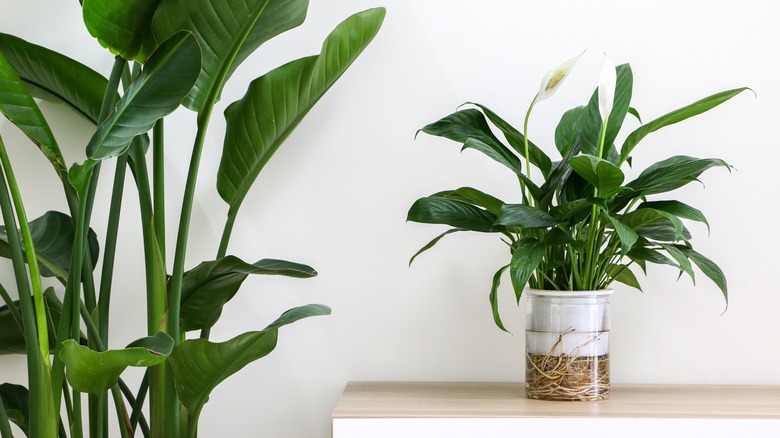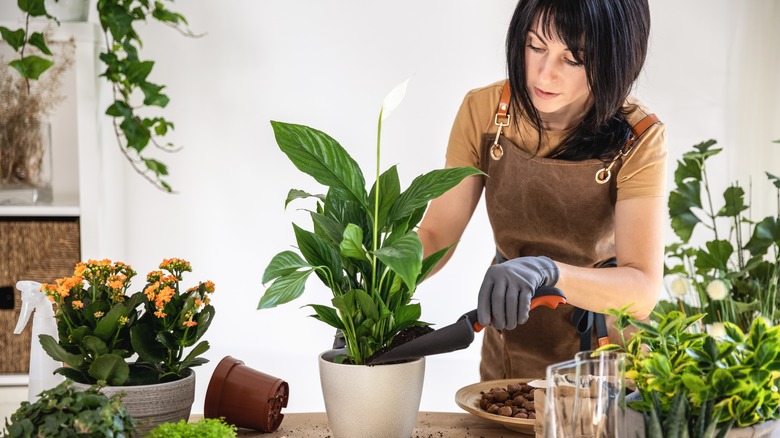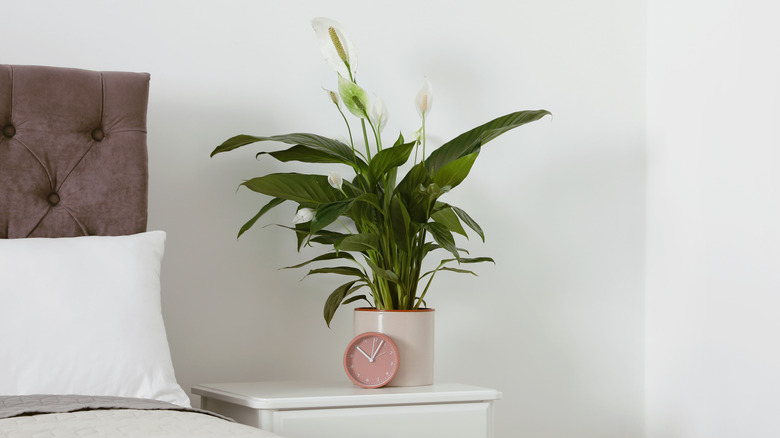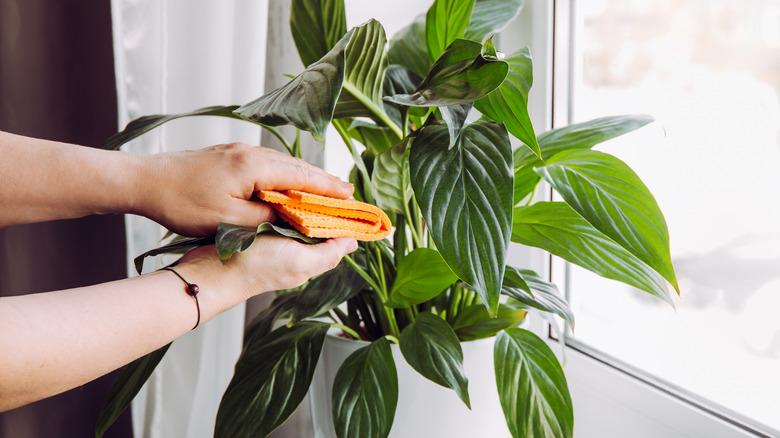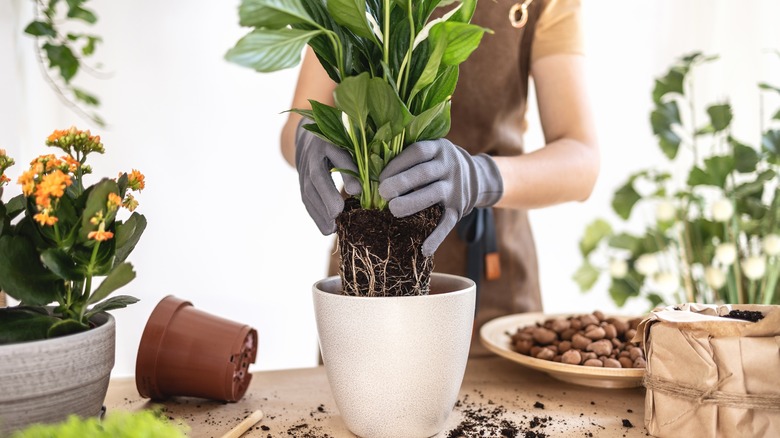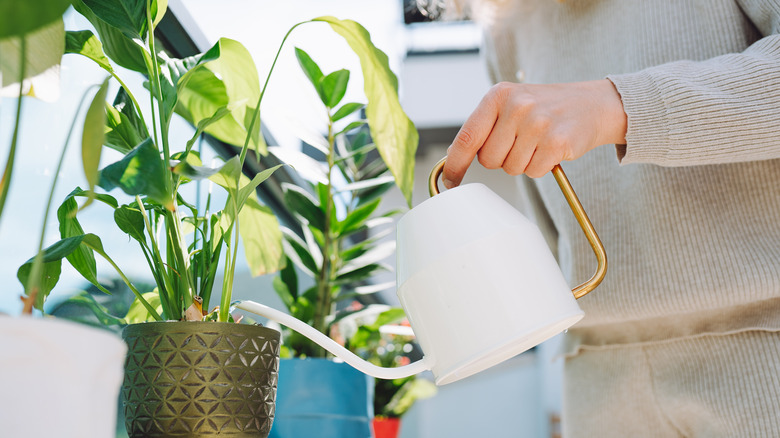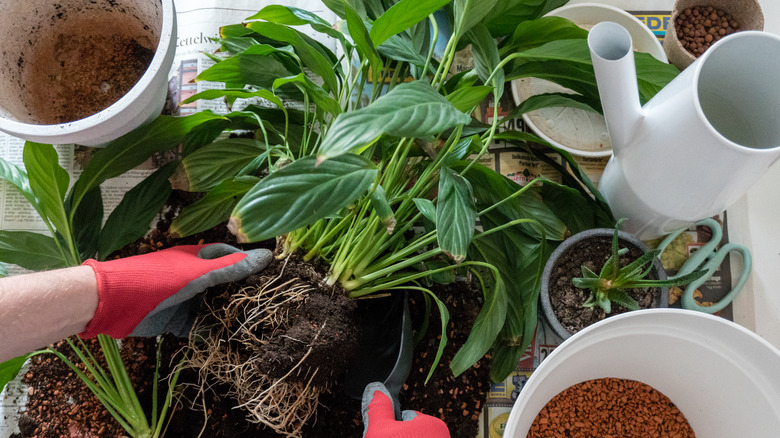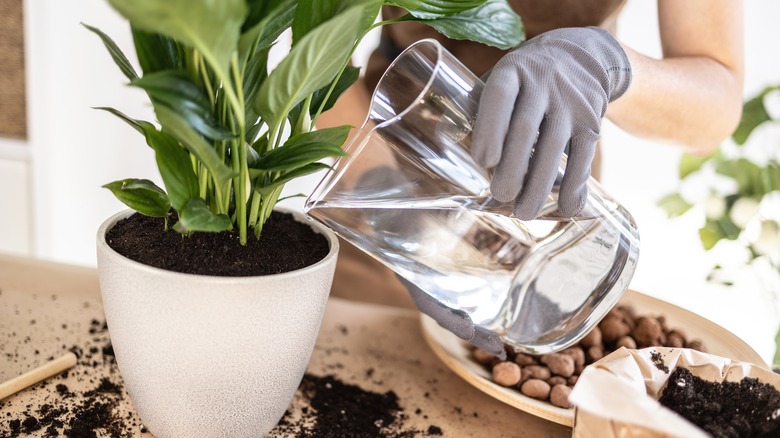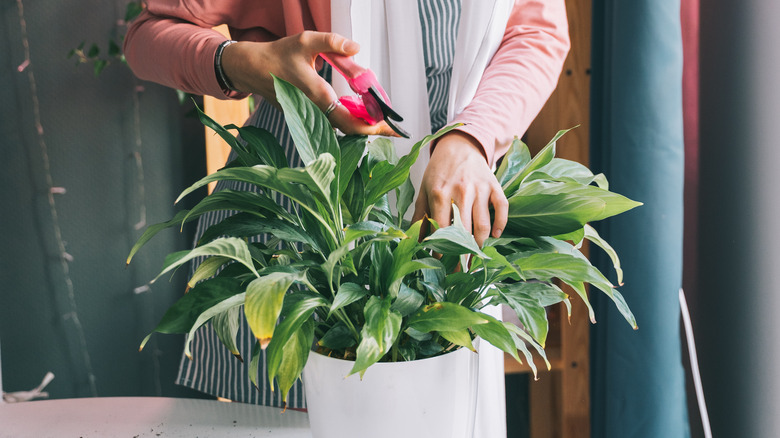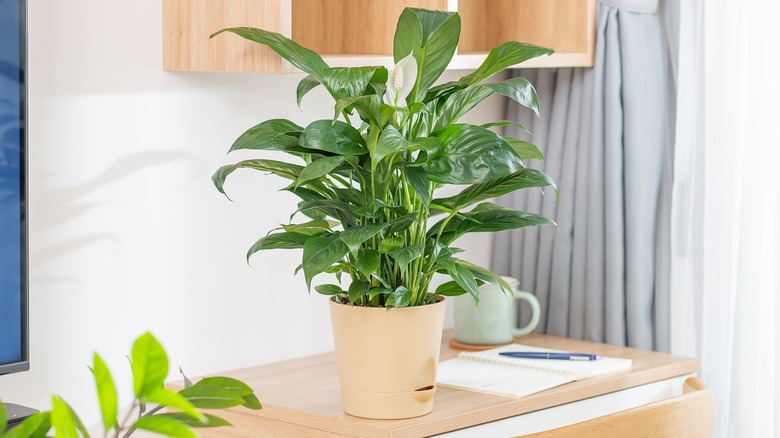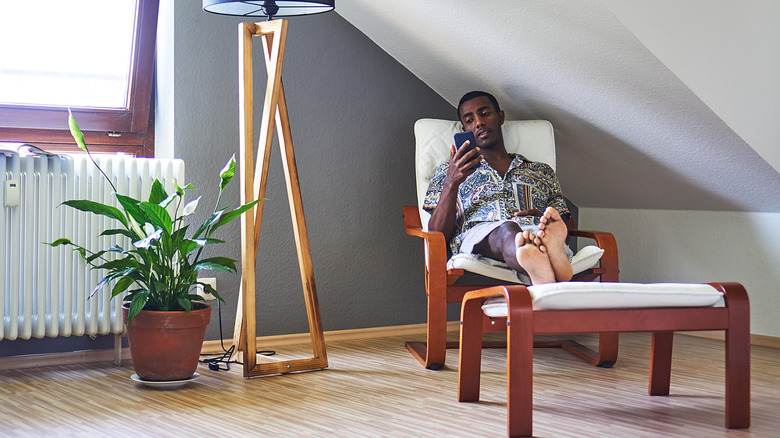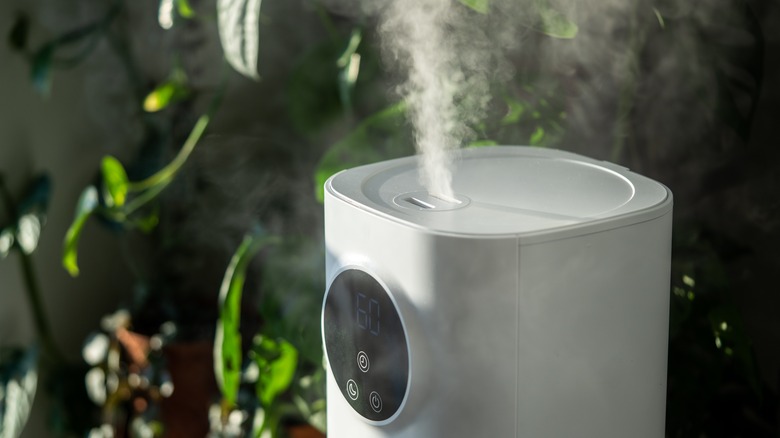12 Hacks To Help Your Peace Lilies Flourish As An Indoor Houseplant
We may receive a commission on purchases made from links.
Peace lilies, or spathiphyllum, are known for being one of the most beginner-friendly houseplants anyone can keep alive since they're so easy to grow. Not only can they tolerate a variety of light conditions, but they don't mind being neglected for a water cycle or two. Despite their ability to handle neglect, we think it's safe to say that you don't want your lilies to just exist in the barest minimum of tolerable conditions. Instead, you want them to thrive and unfurl those big, beautiful white spathes.
To do that, you'll need to give them setups that mimic their natural environments as closely as possible. But don't worry, we're not talking about turning your bedroom into a tropical escape (unless you want to, of course). Luckily, spathiphyllum don't require much, and only a few small tweaks to your current setup will make them the happiest houseplants ever. Here are some of our top picks for how to make your peace lilies flourish.
Transfer your peace lily to a hydroponic setup
Peace lilies are incredibly adaptable plants that can live in lots of different setups, including semi-hydroponic. It's a practically foolproof hack for a thriving peace lily because they love consistently moist environments and would prefer if you left out the fertilizer when giving them a drink. This makes them an excellent candidate for semi-hydroponic setups. Plus, these setups could prevent fungus gnats from breeding in your lily's soil and driving you crazy, which is always a plus.
If you're unfamiliar, hydroponics (also known as hydroculture) is a method of growing plants without soil. Some plant parents prefer hydroponics for their lilies because it lets you reuse materials and saves water as compared to traditional soil planting. Plants are grown in one of two hydroponic systems: water culture, where the plant is put directly into water without support, and medium culture. In medium culture systems, a plant is supported in an inert, porous medium, like expandable clay balls (also known as LECA or Hydroton), lava rocks, perlite, pumice, or Lechuza-PON. The potted lily is then put into a bigger pot filled with water. Sometimes, a liquid fertilizer or nutrient mix is added to the water, but it's dependent on the needs of the plant. The inert medium soaks up the water, delivering it to the root system as needed.
Switch your peace lily's soil to a specialty blend
If hydroponics sounds like too much, don't worry. Peace lilies can do well in any sort of potting soil mix. But if you really want it to flourish with minimal work, then skip the cheapest soil blend and go for an easy-to-water mix like Miracle-Gro Indoor Potting Soil from Lowe's. When a peace lily's soil gets too dry, the plant will wilt, and its leaves will begin to turn yellow, stressing you and your plant out. If you use a blend with coconut coir, it can store excess water and release it into the soil, giving you few extra days between waterings.
However, there's a balance you need to strike as you need a blend that's well-draining and moisture-retaining. We know that sounds contradictory but stick with us here. Peace lily roots need oxygen to grow and can't sit in soggy soil for too long; otherwise, they'll develop root rot. (Fun fact: That might sound bizarre since we just told you to let it live in water in the last tip. But, it's not the water that causes root rot, it's soil-borne fungi that thrive in wet soil.) If you notice too much moisture, mix in some organic matter in it to aerate the soil, like bark, or perlite.
Move your peace lily away from air vents
If your peace lily lives by your air conditioner, radiator, or vents, we're sorry to tell you that it's probably not having much fun there. Spathiphyllum originally come from the tropical rainforests of Central America and Colombia, so they're not great with drafts or bursts of cold air. But they're not big fans of hot air blowing directly on them, either. If you're starting to see damaged leaves , slow growth, or just an overall unhappy-looking plant, it could be that you need to move your lily to a happier habitat.
But where should your plant live? Consider their native home in the rainforests where it's hot and humid, under the tree canopy where they get dappled light. So their ideal spot in your home is somewhere hot, humid, and with indirect sun. Bathrooms, upstairs bedrooms, and that weird nook space are probably great places for it to live. Just make sure it isn't directly in the line of an air draft. Everything else is tweakable since there are ways you can raise the humidity in your home so your favorite plants can thrive.
Wipe down the peace lily's leaves with a damp cloth
Do you regularly dust your plants as part of your chores? If not, you should! Peace lilies, in particular, benefit from this since their big, wide leaves can accumulate dust easily. Besides being an allergen, dusty leaves block sunlight and can prevent your lily from photosynthesizing. Plus, giving your plants a regular cleaning can help you disrupt any start-up pest colonies, especially if you remember to wipe the undersides of the leaves, where they like to live.
If your plant is huge and has a lot of leaves, the easiest way to clean it is by taking it to the sink or shower and giving it a rinse with lukewarm or room-temperature water. Don't go too hot or too cold, as extremes on either side can damage your plant. Use a gentle spray and be sure to get the undersides of the leaves, too. If you've got a larger plant that's just too hard to move, wipe the leaves down with a clean cloth or paper towel that's been moistened with lukewarm water and a drop or two of dishwashing soap. The soap is optional but can help if it's been a while since they've had a good cleaning.
Give your peace lily a pot that's a little snug
Sometimes bigger isn't always better, particularly when it comes to peace lily's living situations. Spathiphyllum flourishes when its roots are a little cozy, and being in a pot that's too big can be too much of a good thing. If the pot is bigger than the root ball, then you need more soil to fill the pot than the plant actually needs. Since you know your lily likes moist soil, you water it often, and more soil needs more water to retain consistent moisture. If the excess soil gets too wet for the root system to manage, the soil fungi start to grow, and root rot can set in. Suddenly, you've got a much bigger problem that could've been avoided by opting for a pot that's a little more snug.
But what size of a pot should you use? The Royal Horticultural Society recommends sticking to the original pot your lily came in for the first year or two and then only repotting if the roots are densely packed. Take the plant out of the pot and look at the root system. If it looks like a bird's nest or pack of dehydrated ramen, then it's time to repot. Go for a pot that's only one to two inches larger than the current one, and remember that peace lilies prefer to be a little more potbound than not. But, if you check it and there's still more soil than roots, you're okay to leave it in the original container.
Skip the tap and opt for other water types for your peace lily
Peace lilies are considered hardy and will tolerate "eh" growing conditions, but they won't give you the full show without getting the stuff they need to thrive. Since they're not fussy with fertilizer and prefer a smaller pot, the main thing you need to really concern yourself with is proper watering. Using the wrong type or temperature of water, unfortunately, is where it could get complicated. Spathiphyllums are sensitive plants when it comes to this, and tap water contains chemicals that could burn its roots or leaves.
First, let's talk about temperature. Too hot or too cold water temperatures can damage the roots and shock the plant. So, you want to use water that's ideally between 62 and 72 degrees Fahrenheit. We know it's tempting to just fill your watering can at the sink, especially when the tap is right there. But, tap water has chlorine, fluoride, and salts that are used to soften water, both of which can burn leaves or injure roots. Instead, opt for distilled, rain, or filtered water. Thankfully, it's easy to acquire these. You can either stick a bucket outside when it rains, let tap water sit out for a day before using so that the chlorine has time to evaporate, or collect water from a dehumidifier pan.
Give your lily room to grow by divvying it up
Let's say you love the pot your lily lives in, but things are moving past cozy and into suffocating. Rather than giving in and getting a bigger pot, let's spread the love and make more peace lilies via a method called propagation by division. Spathiphyllum is one of the few houseplants that can be divided successfully, which is awesome if you've got a rare or variegated cultivar. Unlike water propagation or air layering, propagation by division results in fully-fledged peace lilies with their own root structures, ready to be potted and gifted, or added to your plant hoard.
To start, you'll need a sterilized cutting tool, pots, a potting medium, and your peace lily. Gently remove the plant from its original pot and lay it on its side. Next, use your hands or fingers to gently loosen the roots, separating the mother plant into smaller sections. You can tell where to divide as peace lilies will have grouped clusters of stems that can become their own plant. If the root ball is too tightly bound, use your cutting tool to saw it, being careful not to cut yourself or lose any stems. Plant the new divisions into their pots and water them thoroughly, then place them somewhere that gets bright, indirect light. Don't fertilize your new plants for the first few weeks, as they've just been through a lot and need some time to recover.
Seeing a bud forming? Give your peace lily a little fertilizer
Like having a baby for mammals, pushing a bloom out takes a lot of energy for plants. So when you see your peace lily getting ready to blossom, usually during its growing season of April through October, give it a little energy boost with a dose of fertilizer in its water. You'll likely get a more impressive floral display, and may make things easier on your plant's energy reserves, too. Peace lily's don't have any particular fertilizer needs, so a general 20-20-20 blend should be fine. Jack's Classic All Purpose Fertilizer, available on Amazon, is popular amongst plant parents since it's good for a wide variety and can be used regularly without damaging the foliage. However, just be sure not to give your lily too much and only use it during its growing season.
In fact, over-loving your lily by giving it too much plant food can cause its leaf tips and roots to burn, weakening the plant. However, we know sometimes it's easier to just water all of your plants with the same container, and your others may have more frequent fertilizer needs. So, if you're going to give it a regular hit of plant food, the Missouri Botanical Gardens recommend cutting back to only one-quarter of the recommended normal dose. If you start to see brown tips, though, that's a sign it's getting too many nutrients to handle, so you really should cut back on the fertilizer and let it be.
Get more blooms on your peace lily by pruning dead ones
Peace lily blooms are long-lasting, blooming for over a month with their tall, fragrant spathes slowly changing from a creamy, Calla lily-like white to pale green over time. However, they eventually will begin to deteriorate and turn brown. Rather than letting that spent bloom sit on the plant, prune it off. Not only will you give your lily a tidy look, but cutting back that dead spadix and spathe will encourage it to push out fresh, new blooms in its place.
When you cut off dead blooms (also known as deadheading), you allow the plant to redirect its energy toward producing new growth rather than trying to keep that old flower alive. You don't need to wait until the spathe (the white sail-looking petal) turns brown. Once it's begun to turn green that means it's ready to die off and can be pruned. Use sterilized pruning shears and cut the stem at the base, along with any spent leaves. Wear gloves if you have sensitive skin, as the plant's sap may irritate your skin.
Try watering your spathiphyllum from the bottom
While peace lily's love moist soil, they're not the only ones. Common houseplant pests like springtails and fungus gnats (those little bugs that drive you crazy) absolutely love moist soil too. So how can you keep your plant happy without enticing critters to live in the pot? By watering your peace lily from the bottom. You can use a pot that has a reservoir and wicking system or just pour water into a saucer holding a pot with drainage holes, whichever is more aesthetically pleasing to you.
This method is called sub-irrigation, and spathiphyllum are exceptionally good at handling it. By watering from the bottom, the soil that's closest to the roots gets first dibs to the water. It leaves the top layer dry, preventing pests from getting access to the moisture your plant needs. If you're thinking this sounds like semi-hydroponics, that's true; the theory is the same, but the tools are a little different. Sub-irrigation relies on soil for nutrient delivery to the roots, while hydroculture methods rely on water for nutrient delivery and may use inert, soilless mediums for plant support.
Move your spathiphyllum into better light
If you've ever stumbled on a "low light loving indoor plants" list, then you've undoubtedly seen peace lily come up repeatedly. And while it's true that spathiphyllum can live in low light conditions, the truth is that there's a big difference between surviving and thriving. Yes, peace lilies can survive in low light conditions, but if you want your plant to flourish, you have to let the light in. How much light? Enough that you could comfortably read a book without squinting.
The reality is that peace lilies are tropical plants, so they do best in bright, indirect light . But indirect is important here; think of their original habitat under the rainforest canopy. They would get access to dappled light that reached the forest floor, so they have adapted to thrive with that sort of light. If they sit in a window that gets bright midday sun, their leaves and spathes could scorch under the direct sunlight. Instead, try to put them in a spot that has filtered natural light through blinds or a shade.
Your peace lily loves humidity, so add a humidifier to its space
Winters are harsh on all of us, including peace lilies. Not only does our skin dry out in the cold, dry air, but spathiphyllum cells do, too. Peace lilies love humidity, so if your home is on the drier side, especially in the winter, it's time to invest in a room humidifier and crank that baby up. Humidifiers are great because they're effective, and come in a variety of sizes and prices (like this teeny cat humidifier on Amazon that's only $9.99). These do the heavy lifting of keeping your plant's environment in tip-top shape while you're busy earning more money to add to your plant hoard.
If a humidifier isn't an option, there are a few ways to raise the humidity in your home to make your peace lily happy. Misting leaves is an option, but the foliage may dry out too quickly for it to help, and you may make your plant prone to fungal or bacterial diseases that take advantage of the moisture. If you still want to give it a go, start misting in the morning and expect to do it multiple times a day. You can also put your plants near each other so they can absorb humidity from one another's soil and foliage (known as transpiration). Or, use shallow trays filled with water and gravel to increase humidity. Put these under your plants, making sure the bottom of the pot is above the water line. Otherwise, you could overload the soil with too much water and cause root rot to set in.

